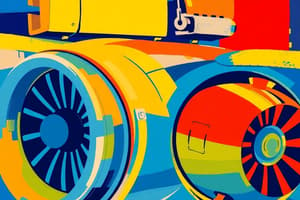Podcast
Questions and Answers
What is a Four-stroke cycle?
What is a Four-stroke cycle?
- A valve that exposes ported holes to allow the entrance and exit of gases
- An engine that requires one complete revolution of the crankshaft to fire each piston once
- An engine requiring two complete cycles of the crankshaft to fire each piston once (correct)
- An engine design with valves on one side of the cylinder
What is a Two-stroke cycle?
What is a Two-stroke cycle?
An engine that requires one complete revolution of the crankshaft to fire each piston once.
What is a Reed valve?
What is a Reed valve?
Where the air-fuel mixture is drawn into the crankcase.
What is a Rotary Valve?
What is a Rotary Valve?
What is an L-head engine?
What is an L-head engine?
What is a T-head engine?
What is a T-head engine?
What is an F-head engine?
What is an F-head engine?
What is an I-head engine?
What is an I-head engine?
What is a Valve train?
What is a Valve train?
What is a Rocker arm?
What is a Rocker arm?
What is a Push rod?
What is a Push rod?
What is a Rocker shaft?
What is a Rocker shaft?
What is a Ball pivot?
What is a Ball pivot?
What is an Overhead camshaft?
What is an Overhead camshaft?
What is Detonation?
What is Detonation?
What is Preignition?
What is Preignition?
Who developed the Ricardo combustion chamber for L-head engines?
Who developed the Ricardo combustion chamber for L-head engines?
What is a Squish area?
What is a Squish area?
What is a Hemispherical combustion chamber?
What is a Hemispherical combustion chamber?
What is a Wedge chamber?
What is a Wedge chamber?
What does Radical refer to in engine design?
What does Radical refer to in engine design?
What does Inline describe in engine components?
What does Inline describe in engine components?
What is a Slant engine?
What is a Slant engine?
What is an Inclined engine?
What is an Inclined engine?
What is a V-type engine?
What is a V-type engine?
What is a Horizontal-opposed engine?
What is a Horizontal-opposed engine?
What is a Firing order?
What is a Firing order?
What are Engine mounts?
What are Engine mounts?
What is a Rotary engine?
What is a Rotary engine?
What is a Rotor?
What is a Rotor?
What is a Rotor housing?
What is a Rotor housing?
What is an Eccentric Shaft?
What is an Eccentric Shaft?
What is a Miller-cycle engine?
What is a Miller-cycle engine?
What is Natural gas?
What is Natural gas?
What characterizes a Variable compression engine?
What characterizes a Variable compression engine?
Flashcards are hidden until you start studying
Study Notes
Engine Types and Cycles
- Four-stroke cycle: Requires two complete crankshaft cycles to fire each piston once.
- Two-stroke cycle: Only needs one complete crankshaft revolution to fire each piston.
Engine Valves
- Reed valve: Allows air-fuel mixture to enter the crankcase.
- Rotary valve: Exposes ported holes for gas intake and exhaust.
Engine Designs
- L-head: Features both valves on one side of the cylinder.
- T-head: Has intake and exhaust valves located on opposite sides of the cylinder.
- F-head: One valve is in the block, the other is in the cylinder head.
- I-head: Contains both valves in the cylinder head.
Valve Mechanisms
- Valve train: Comprises various parts involved in valve operation.
- Rocker arm: Directs downward motion onto the valve stem.
- Push rod: Connects the valve lifter to the rocker arm.
- Rocker shaft: A shaft supporting rocker arms in some engine designs.
- Ball pivot: A mechanism for rocker arm pivoting.
Camshaft and Combustion Dynamics
- Overhead camshaft: Positioned above the cylinder head; driven by a timing mechanism.
- Detonation: Rapid fuel charge ignition causing a knocking noise in the combustion chamber.
- Preignition: Occurs when fuel ignites prematurely.
Combustion Chamber Design
- Ricardo: Innovated a combustion chamber design originally for L-head engines, adapted for I-head engines.
- Squish area: Gap between the piston head at top dead center (TDC) and the cylinder head.
- Hemispherical combustion chamber: Dome-shaped design enhancing engine aspiration with reduced heat loss.
- Wedge chamber: Features a wedge shape, efficient and conducive to mass production.
Engine Configuration
- Radical: A line perpendicular to a shaft or cylinder center line.
- Inline: Components arranged in a straight row.
- Slant engine: Cylinders tilted from the vertical plane in an inline arrangement.
- Inclined engine: All cylinders are aligned in a straight row.
- V-type engine: Arranges two banks of cylinders at angles of 60 or 90 degrees.
- Horizontal-opposed engine: Positioned perpendicular to the vehicle chassis.
Engine Operations
- Firing order: Sequence in which the engine cylinders fire.
- Engine mounts: Support systems made of metal, rubber, or plastic to secure the engine to the chassis; may include liquid-filled options.
Rotary Engines
- Rotary engine: Uses triangular rotors instead of pistons for the engine cycle, also known as a Wankel engine.
- Rotor: A moving part in electromagnetic systems like motors and generators.
- Rotor housing: Metal casing with slots for rotor vanes.
- Eccentric shaft: Key component in rotary engines, its configuration depends on the number of rotors.
Advanced Concepts
- Miller-cycle: Extended intake valve opening during the piston’s compression stroke, enhancing efficiency.
- Natural gas: General term for petroleum-based gases such as propane and liquefied petroleum gas.
- Variable compression engine: Adjusts its compression ratio to optimize fuel efficiency.
Studying That Suits You
Use AI to generate personalized quizzes and flashcards to suit your learning preferences.




